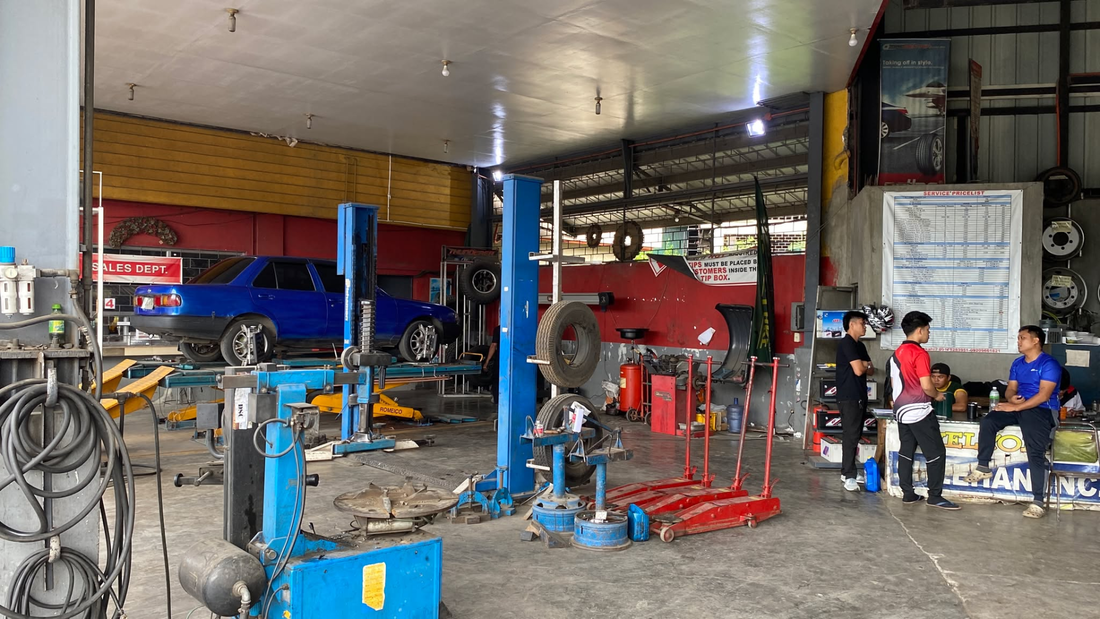TIRE, BATTERY, AND LUBRICANT SERVICES
|
This service covers repair and maintenance that has to do with the vehicle's tires, rims and batteries.
|
TIRES top
WHEEL CHECK-UP topAs a rule of thumb, tire check-ups should be performed once every 8000 kilometers. Less is recommended if you are putting your tire on a lot of stress like travelling off-road. Also, if you feel like there is something different with how the car moves, do not hesitate for a check-up. After all this service can help make your ride more fuel-efficient and reduce wear and tear to your vehicle overall.
|
WHEEL ALIGNMENT topWheel alignment adjusts the angles of the wheels to make sure that all wheels are parallel and perpendicular to the ground. Its purpose is to maximize tire life by evening out wear and tear; and to make sure that the car moves straight when driven straight on a good road. This service may be one or all of these three: Toe, Camber and Caster.
|
Toe-in, Toe-out top Toe tire wear. C/O ozebiz.com.au
The edges of a tread is pointing in (out) when it has a toe-in (toe-out) problem (left image). The direction the tire is rolling and the direction car is moving is different (right image)., It causes this damage, which is a result of a lot of unnecessary friction on tire treads. Additionally, this wastes energy because you need to steer the car towards a certain direction for it to move in straight line.
|
Camber top Camber Toe tire wear.
One lateral side of the tread is worn out (see left) when it has a camber problem. Not all the tread hits the ground, only one side of it (See right). This causes the damage mentioned earlier.
There are drivers that prefer negative camber because of its increased grip while turning. However, this comes at the cost of lesser grip on a straight drive, and more importantly, tire life. |
Caster topCaster is the angle at which your wheel turns when steering. There is no standard angle at which this caster should be. Usually, heavy vehicles have less angle because it increases steering effort. But regardless, the caster angle for both wheels must be the same to avoid having the vehicle tendency to pull to one side.
|
TIRE VULCANIZING topCars face a lot of uncertainty during its trips. Since, tires are the ones on contact with the ground, they take the worst of it. Puncturing is one of the most common damage it takes, and vulcanizing can easily fix it. In a nutshell, it is the process of sealing holes on a tire. It is not a straight away patch, the surface is prepared for the liquid patch before it is applied and left to harden.
|
WHEEL BALANCING topPart of a tire's wear and tear is it preferring a certain side of the wheel when either stationary or moving. Some of the causes are prolonged parking (a week or more), hopping the car, etc. The damage causes the vehicle to vibrate that worsens as you increase speed.
This damage is fixed by wheel balancing. The wheel is checked for its static (stationary) or dynamic (moving) balance. Metal weights are placed on the wheel to fix it. |
TIRE ROTATION topTires wear out unevenly, front tires wear twice as fast. This is because it receives the stress from turning and braking. Right tires usually wear out more, because right turns are sharper and more frequent than left turns. Sidewalls also get bruised from hitting curbs while parallel parking. To fix all these, the positions of the tires are rotated to avoid accelerated wear and tear to a single tire.
|
LUBRICANTS top
CARBON CLEAN topAs you use your vehicle, residue on the engine builds up from the consumption of fuel and byproduct of lubricants. This causes unwanted friction and leak which makes your engine to be less efficient, noisy and emit smoke. Carbon clean fixes this, a cleaning fluid temporarily takes the fuel's place to remove residues inside the engine.
|
CHANGE OIL topMotor oil lessens wear and tear on your engine. This service drains that old motor oil away and replaces it with a new one. In vehicle manuals, it is recommended you get this once every 7,500km. However, that is under ideal conditions when the car is used for three short trips (>15km) a day. Typically, auto shops suggest change oils every 5,000km for vehicles used on long trips. Together with it, oil filters must be changed. Why? oil filters are now smaller than what they used to be, and it has less filtering capacity. The old rule of having oil filters changed once every two change oils is a thing of the past.
|
GREASING topThe wheel has a bearing in its center. It attaches the wheels to the chassis and lets the wheel roll around the bearing. The bearing will experience friction when the tire is rolling so it is necessary to grease it often to minimize wear and tear. This part is checked when you avail of our wheel check-up service.
|
BATTERIES top
BATTERY RECHARGING top
|
A dead or weak battery can leave you stranded, but our battery charging service ensures your vehicle stays powered and ready to go. Whether your battery needs a quick boost or a full recharge, we use reliable equipment to restore its charge efficiently. Our experts will also check for any underlying issues, such as corrosion or faulty connections, to ensure optimal battery performance. Drive with confidence, knowing your battery is in peak condition!
|












